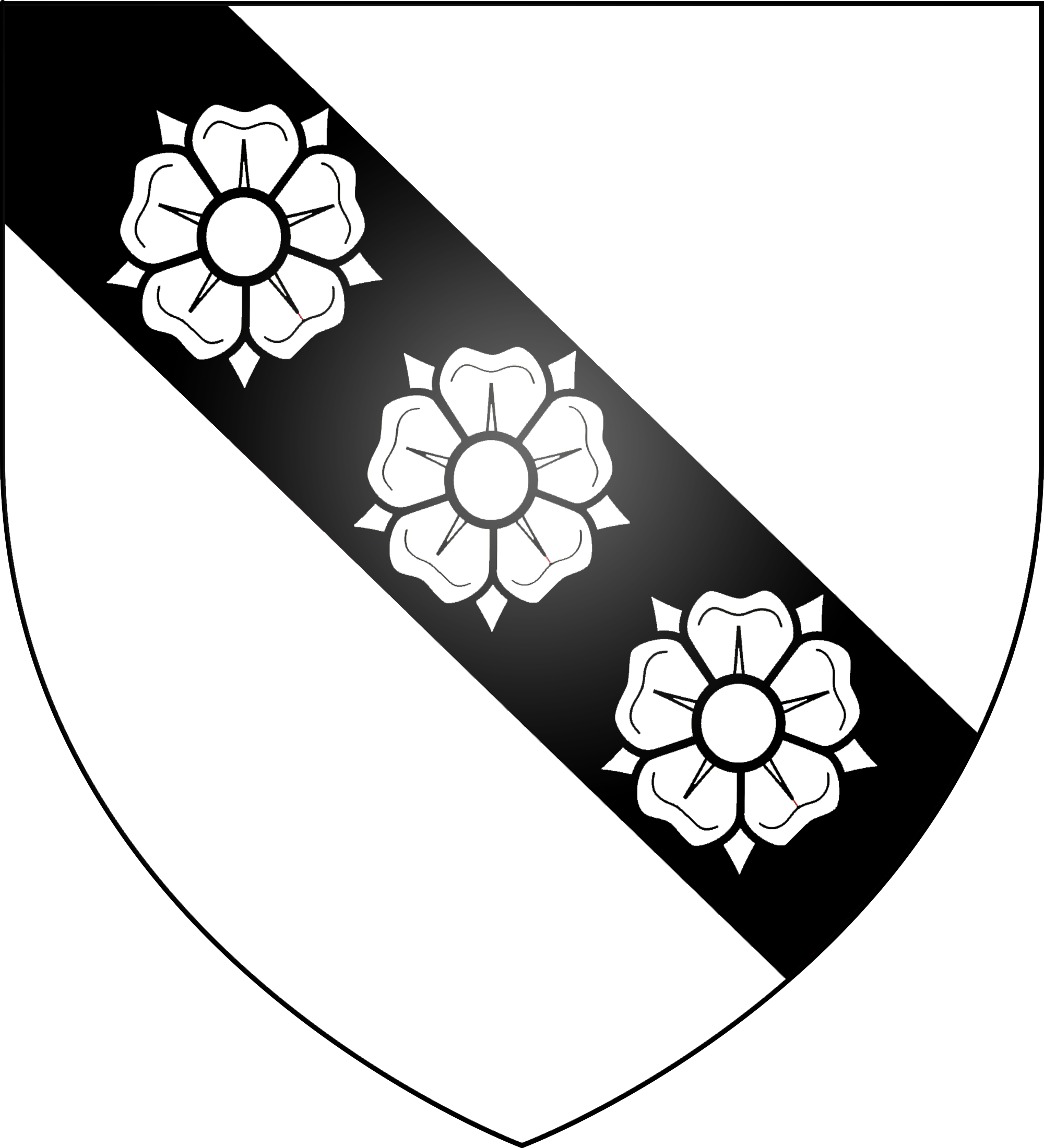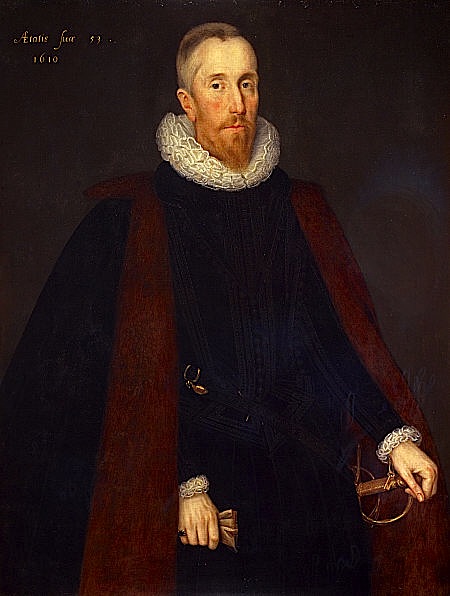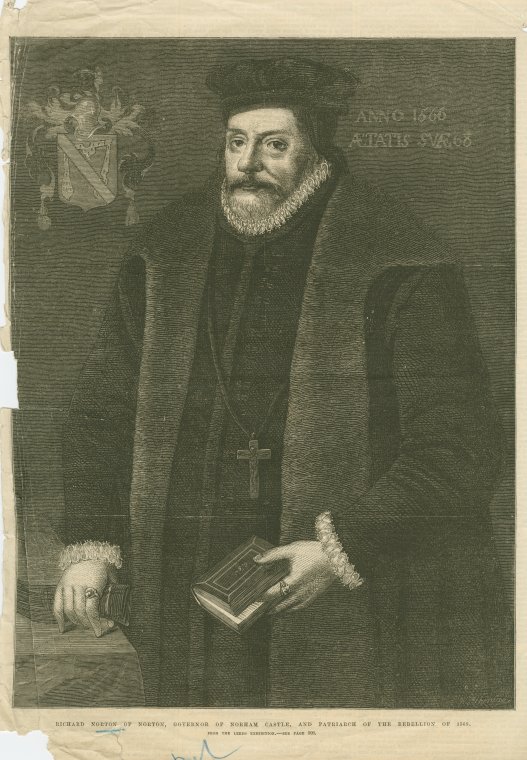|
Robert Carey, 1st Earl Of Monmouth
Robert Carey, 1st Earl of Monmouth (ca. 1560 – 12 April 1639) (or "Cary") was an English nobleman and courtier. He was the youngest son of Henry Carey, 1st Baron Hunsdon, chamberlain and first cousin of Queen Elizabeth I, and Anne Morgan, daughter of Sir Thomas Morgan and Anne Whitney. Biography As a young man he accompanied several diplomatic missions abroad and took part in military expeditions. In 1587 he joined in the attempt to relieve Sluys. In 1588 he served as a volunteer against the Spanish Armada, and commanded a regiment in the Earl of Essex's expedition to Normandy in support of the Protestant Henry IV of France in 1591, taking part in the siege of Rouen. He was knighted by Essex the same year for having by his intercession with the Queen procured his recall. In October 1593 he brought the Scottish rebel Francis Stewart, 5th Earl of Bothwell, as a guest to Carlisle Castle. This alarmed his brother-in-law, Thomas Scrope, who was Warden of the West March, beca ... [...More Info...] [...Related Items...] OR: [Wikipedia] [Google] [Baidu] |
Henry Carey, 1st Baron Hunsdon
Henry Carey, 1st Baron Hunsdon Knight of the Garter, KG Privy Council of England, PC (4 March 1526 – 23 July 1596), was an English nobleman and courtier. He was the patron of the Lord Chamberlain's Men, William Shakespeare's playing company. The son of Mary Boleyn, he was a cousin of Elizabeth I of England, Elizabeth I. Early life Henry Carey was the second child of William Carey (courtier), William Carey and Mary Boleyn who was the sister of Anne Boleyn, the second wife and Queen of Henry VIII of England, Henry VIII. Carey and his elder sister Catherine Carey, Lady Knollys, Catherine came under the wardship of their maternal aunt Anne Boleyn, who was engaged to Henry VIII at the time. The children still had active contact with their mother, who remained on good terms with her sister, until Mary's secret elopement with a soldier, William Stafford (1500-1565), William Stafford (later Lord of Chebsey) in 1535. Anne Boleyn acted as her nephew's patron and provided him with an ... [...More Info...] [...Related Items...] OR: [Wikipedia] [Google] [Baidu] |
Warden Of The Marches
The Lord Warden of the Marches was an office in the governments of Scotland and England. The holders were responsible for the security of the border between the two nations, and often took part in military action. They were also responsible, along with 'Conservators of the truce', for administering the special type of border law known as March law. The Marches on both sides of the border were traditionally split into West, Middle and East, each with their own warden answerable to the Lord Warden-general. The English Western March was based on Carlisle and the Eastern March on Berwick-upon-Tweed. The offices became unnecessary after the union of the crowns of England and Scotland under King James in 1603. For England Warden of the Marches * Robert de Clifford (1297–) (died 1314) *John de Warenne, 7th Earl of Surrey (1327–) *Henry de Percy, 2nd Baron Percy (1328–) *Ralph Neville, 2nd Baron Neville de Raby and Henry de Percy, 2nd Baron Percy (1334–) (jointly) * Gilbert W ... [...More Info...] [...Related Items...] OR: [Wikipedia] [Google] [Baidu] |
Charles I Of England
Charles I (19 November 1600 – 30 January 1649) was King of England, Scotland, and Ireland from 27 March 1625 until Execution of Charles I, his execution in 1649. He was born into the House of Stuart as the second son of King James VI of Scotland, but after his father inherited the English throne in 1603, he moved to England, where he spent much of the rest of his life. He became heir apparent to the kingdoms of England, Scotland, and Ireland in 1612 upon the death of his elder brother, Henry Frederick, Prince of Wales. An unsuccessful and unpopular attempt to marry him to the Spanish Habsburg princess Maria Anna of Spain, Maria Anna culminated in an eight-month visit to Spain in 1623 that demonstrated the futility of the marriage negotiation. Two years later, he married the House of Bourbon, Bourbon princess Henrietta Maria of France. After his 1625 succession, Charles quarrelled with the Parliament of England, English Parliament, which sought to curb his royal prerogati ... [...More Info...] [...Related Items...] OR: [Wikipedia] [Google] [Baidu] |
Alexander Seton, 1st Earl Of Dunfermline
Alexander Seton, 1st Earl of Dunfermline (1555–1622) was a Scottish lawyer, judge and politician. He served as Lord President of the Court of Session from 1598 to 1604, Lord Chancellor of Scotland from 1604 to 1622 and as a Lord High Commissioner to the Parliament of Scotland. Early life Born at Seton Palace, East Lothian, he was the son of George Seton, 7th Lord Seton, and Isobell Hamilton. The Setons remained a Roman Catholic family after the Scottish Reformation of 1560, and continued to support Mary, Queen of Scots, after her abdication and exile in England. Alexander Seton was educated at the German and Roman College in Rome from June 1571 to December 1578. Alexander was noted learning Italian and science (philosophy) in Rome by Baptista da Trento in 1577 in a letter describing plots to marry Elizabeth I of England to the Earl of Leicester and re-instate Mary in Scotland. The family historian Viscount Kingston heard that he was skilled in mathematics, heraldry and arch ... [...More Info...] [...Related Items...] OR: [Wikipedia] [Google] [Baidu] |
Dunfermline Palace
Dunfermline Palace is a ruined former Scottish royal palace and important tourist attraction in Dunfermline, Fife, Scotland. It is currently, along with other buildings of the adjacent Dunfermline Abbey, under the care of Historic Environment Scotland as a scheduled monument. Origins Dunfermline was a favourite residence of many Scottish monarchs. Documented history of royal residence there begins in the 11th century with Malcolm III who made it his capital. His seat was the nearby Malcolm's Tower, a few hundred yards to the west of the later palace. In the medieval period David II and James I of Scotland were both born at Dunfermline. Dunfermline Palace is attached to the historic Dunfermline Abbey, occupying a site between the abbey and deep gorge to the south. It is connected to the former monastic residential quarters of the abbey via a gatehouse above a pend (or ''yett''), one of Dunfermline's medieval gates. The building therefore occupies what was originally the g ... [...More Info...] [...Related Items...] OR: [Wikipedia] [Google] [Baidu] |
Norham Castle
Norham Castle (sometimes Nornam) is a castle in Northumberland, England, overlooking the River Tweed, on the border between England and Scotland. It is a Grade I listed building and a Scheduled Ancient Monument. The castle saw much action during the wars between England and Scotland. Early history The castle was founded when Ranulf Flambard, Bishop of Durham from 1099 to 1128, gave orders for its construction in 1121, in order to protect the property of the bishopric in north Northumberland, from incursions by the Scots. In 1136 David I of Scotland invaded Northumberland and captured the castle. It was soon handed back to the bishopric, but was captured again in 1138 during another invasion. This time, the structure of the castle was substantially damaged. It remained derelict until Hugh de Puiset, Bishop of Durham from 1153 to 1195, had the castle rebuilt. The work was probably directed by Richard of Wolviston, who was the bishop's architect. In 1174 Hugh de Puiset supported ... [...More Info...] [...Related Items...] OR: [Wikipedia] [Google] [Baidu] |
George Home, 1st Earl Of Dunbar
George Home, 1st Earl of Dunbar, KG, PC (ca. 155620 January 1611) was, in the last decade of his life, the most prominent and most influential Scotsman in England. His work lay in the King's Household and in the control of the State Affairs of Scotland and he was the King's chief Scottish advisor. With the full backing and trust of King James he travelled regularly from London to Edinburgh via Berwick-upon-Tweed. In Scotland Home was the third son of Sir Alexander Home of Manderston, Berwickshire, by his spouse Janet, daughter of George Home of Spott. He was introduced, at the age of 26, to the Court of sixteen-year-old James VI by a relative, Alexander Home, 6th Lord Home. Establishing himself as a favourite, he was in the retinue which accompanied King James VI to Norway and Denmark to collect his future Queen. James Melville of Halhill mentions that Home did not sail with the king, but in one of three other ships, along with Lewis Bellenden, John Carmichael, the Provost of ... [...More Info...] [...Related Items...] OR: [Wikipedia] [Google] [Baidu] |
Holyrood Palace
The Palace of Holyroodhouse ( or ), commonly referred to as Holyrood Palace or Holyroodhouse, is the official residence of the British monarch in Scotland. Located at the bottom of the Royal Mile in Edinburgh, at the opposite end to Edinburgh Castle, Holyroodhouse has served as the principal royal residence in Scotland since the 16th century, and is a setting for state occasions and official entertaining. The late Queen Elizabeth II spent one week in residence at Holyroodhouse at the beginning of each summer, where she carried out a range of official engagements and ceremonies. The 16th-century historic apartments of Mary, Queen of Scots, and the State Apartments, used for official and state entertaining, are open to the public throughout the year, except when members of the royal family are in residence. The Queen's Gallery was built at the western entrance to the Palace of Holyroodhouse and opened in 2002 to exhibit works of art from the Royal Collection. The gardens of ... [...More Info...] [...Related Items...] OR: [Wikipedia] [Google] [Baidu] |
James I Of England
James VI and I (James Charles Stuart; 19 June 1566 – 27 March 1625) was King of Scotland as James VI from 24 July 1567 and King of England and King of Ireland, Ireland as James I from the Union of the Crowns, union of the Scottish and English crowns on 24 March 1603 until his death in 1625. The kingdoms of Kingdom of Scotland, Scotland and Kingdom of England, England were individual sovereign states, with their own parliaments, judiciaries, and laws, though both were ruled by James in personal union. James was the son of Mary, Queen of Scots, and a great-great-grandson of Henry VII of England, Henry VII, King of England and Lord of Ireland, and thus a potential successor to all three thrones. He succeeded to the Scottish throne at the age of thirteen months, after his mother was compelled to abdicate in his favour. Four different regents governed during his minority, which ended officially in 1578, though he did not gain full control of his government until 1583. In 1603, ... [...More Info...] [...Related Items...] OR: [Wikipedia] [Google] [Baidu] |
Robert Ker, 1st Earl Of Roxburghe
Robert Ker, 1st Earl of Roxburghe (1650) was a Scottish nobleman. Early life He was the eldest son of William Ker of Cessford (died 1605), and Janet Douglas. His mother was the widow of James Tweedie of Drumelzier, and the third daughter of Sir James Douglas of Drumlanrig. His paternal grandfather was Sir Walter Ker of Cessford (died ), who fought against Mary, Queen of Scots, both at Carberry Hill and at Langside. Career He was knighted on 17 May 1590 at the coronation of Anne of Denmark. In December 1590 he was involved in the assassination of William Kerr of Ancram who was ambushed on the stairs at the entry to his lodging by two of Robert's followers who shot him with a pistol called a "dag". Ker had married Margaret Maitland, a niece of the Chancellor, John Maitland of Thirlestane. In 1592 Ker was able to help Maitland into the favour of Anne of Denmark. Ker was Deputy Keeper of Liddesdale and Warden of the Middle March in 1593. In August 1594 he performed in th ... [...More Info...] [...Related Items...] OR: [Wikipedia] [Google] [Baidu] |
Border Reivers
Border reivers were Cattle raiding, raiders along the Anglo-Scottish border from the late 13th century to the beginning of the 17th century. They included both Scotland, Scottish and England, English people, and they raided the entire border country without regard to their victims' nationality. Their heyday was in the last hundred years of their existence, during the time of the House of Stuart in the Kingdom of Scotland and the House of Tudor in the Kingdom of England. Background Scotland and England were frequently at war during the late Middle Ages. During these wars, the livelihood of the people on the Borders was devastated by the contending armies. Even when the countries were not formally at war, tension remained high, and royal authority in either or both kingdoms was often weak, particularly in remote locations. The difficulty and uncertainties of basic human survival meant that communities and/or people kindred to each other would seek security through group streng ... [...More Info...] [...Related Items...] OR: [Wikipedia] [Google] [Baidu] |
Northumberland
Northumberland () is a county in Northern England, one of two counties in England which border with Scotland. Notable landmarks in the county include Alnwick Castle, Bamburgh Castle, Hadrian's Wall and Hexham Abbey. It is bordered by land on three sides; by the Scottish Borders region to the north, County Durham and Tyne and Wear to the south, and Cumbria to the west. The fourth side is the North Sea, with a stretch of coastline to the east. A predominantly rural county with a landscape of moorland and farmland, a large area is part of Northumberland National Park. The area has been the site of a number of historic battles with Scotland. Name The name of Northumberland is recorded as ''norð hẏmbra land'' in the Anglo-Saxon Chronicle, meaning "the land north of the Humber". The name of the kingdom of ''Northumbria'' derives from the Old English meaning "the people or province north of the Humber", as opposed to the people south of the Humber Estuary. History ... [...More Info...] [...Related Items...] OR: [Wikipedia] [Google] [Baidu] |







